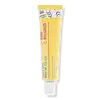What's inside
What's inside
 Key Ingredients
Key Ingredients

 Benefits
Benefits

 Concerns
Concerns

No concerns
 Ingredients Side-by-side
Ingredients Side-by-side

Water
Skin ConditioningCetearyl Alcohol
EmollientCapryloyl Glycerin/Sebacic Acid Copolymer
Skin ConditioningCaprylic/Capric Triglyceride
MaskingIsopropyl Myristate
EmollientCarnitine
CleansingCaffeine
Skin ConditioningRuscus Aculeatus Root Extract
AstringentButylene Glycol
HumectantChenopodium Quinoa Seed Extract
Skin ConditioningSqualane
EmollientHyaluronic Acid
HumectantPolysorbate 60
EmulsifyingSophora Japonica Flower Extract
Skin ProtectingVitis Vinifera Juice Extract
AntioxidantCamellia Sinensis Leaf Extract
AntimicrobialLepidium Sativum Sprout Extract
Skin ConditioningRubus Idaeus Leaf Extract
Skin ConditioningSymphytum Officinale Leaf Extract
Skin ConditioningStrelitzia Nicolai Seed Aril Extract
Skin ConditioningCitrus Limon Fruit Oil
AstringentCitrus Aurantifolia Fruit Oil
MaskingLitsea Cubeba Fruit Oil
MaskingCitrus Nobilis Oil
MaskingCitrus Aurantium Dulcis Oil
MaskingPhenoxyethanol
PreservativeEthylhexylglycerin
Skin ConditioningWater, Cetearyl Alcohol, Capryloyl Glycerin/Sebacic Acid Copolymer, Caprylic/Capric Triglyceride, Isopropyl Myristate, Carnitine, Caffeine, Ruscus Aculeatus Root Extract, Butylene Glycol, Chenopodium Quinoa Seed Extract, Squalane, Hyaluronic Acid, Polysorbate 60, Sophora Japonica Flower Extract, Vitis Vinifera Juice Extract, Camellia Sinensis Leaf Extract, Lepidium Sativum Sprout Extract, Rubus Idaeus Leaf Extract, Symphytum Officinale Leaf Extract, Strelitzia Nicolai Seed Aril Extract, Citrus Limon Fruit Oil, Citrus Aurantifolia Fruit Oil, Litsea Cubeba Fruit Oil, Citrus Nobilis Oil, Citrus Aurantium Dulcis Oil, Phenoxyethanol, Ethylhexylglycerin
Water
Skin ConditioningPropanediol
SolventButylene Glycol
HumectantGlycerin
Humectant1,2-Hexanediol
Skin ConditioningSodium Polyacryloyldimethyl Taurate
Emulsion StabilisingCetyl Ethylhexanoate
EmollientCorn Starch Modified
AbsorbentIlex Paraguariensis Leaf Extract
PerfumingCetearyl Olivate
Sorbitan Olivate
EmulsifyingPanthenol
Skin ConditioningAllantoin
Skin ConditioningAdenosine
Skin ConditioningTocopherol
AntioxidantHelianthus Annuus Seed Oil
EmollientHydrolyzed Hyaluronic Acid
HumectantSodium Hyaluronate
HumectantHyaluronic Acid
HumectantCaffeine
Skin ConditioningAcetyl Tetrapeptide-5
HumectantCichorium Intybus Root Extract
MaskingWater, Propanediol, Butylene Glycol, Glycerin, 1,2-Hexanediol, Sodium Polyacryloyldimethyl Taurate, Cetyl Ethylhexanoate, Corn Starch Modified, Ilex Paraguariensis Leaf Extract, Cetearyl Olivate, Sorbitan Olivate, Panthenol, Allantoin, Adenosine, Tocopherol, Helianthus Annuus Seed Oil, Hydrolyzed Hyaluronic Acid, Sodium Hyaluronate, Hyaluronic Acid, Caffeine, Acetyl Tetrapeptide-5, Cichorium Intybus Root Extract
 Reviews
Reviews

Ingredients Explained
These ingredients are found in both products.
Ingredients higher up in an ingredient list are typically present in a larger amount.
Butylene Glycol (or BG) is used within cosmetic products for a few different reasons:
Overall, Butylene Glycol is a safe and well-rounded ingredient that works well with other ingredients.
Though this ingredient works well with most skin types, some people with sensitive skin may experience a reaction such as allergic rashes, closed comedones, or itchiness.
Learn more about Butylene GlycolCaffeine is most associated with coffee, tea, and cacao. In skincare, it helps with calming inflammation and is rich in antioxidants.
While caffeine is used to treat cellulite and and dark circles, further studies are needed to prove this. It has been believed to help with these skin conditions due to its ability to dilate blood vessels and increase blood flow.
Some studies are looking into caffeine's ability to protect against UV rays.
Learn more about CaffeineHyaluronic acid is naturally found in healthy skin. It is a humectant, meaning it draws moisture to your skin.
This ingredient helps hydrate, soothe, and protect the skin.
What makes hyaluronic acid so hydrating? It has the capacity to bind or hold large amounts of water.
Fun fact: It is already naturally found in our bodies, such as the fluids of our eyes and our joints.
Studies find this ingredient to have anti-inflammatory and anti-microbial properties. This can help speed up wound-healing.
Hyaluronic acid can be irritating if the molecule has a low-molecular weight, or if the molecules are small.
One study found low-molecular weight hyaluronic acid to be pro-inflammatory, meaning some people may experience irritation. This is because our bodies use hyaluronic acid in the wound-healing process to signal to our bodies, via irritation, that something needs healing.
The same study found high-molecular weight hyaluronic acid to be anti-inflammatory.
These are some other common types of Hyaluronic Acid:
Learn more about Hyaluronic AcidWater. It's the most common cosmetic ingredient of all. You'll usually see it at the top of ingredient lists, meaning that it makes up the largest part of the product.
So why is it so popular? Water most often acts as a solvent - this means that it helps dissolve other ingredients into the formulation.
You'll also recognize water as that liquid we all need to stay alive. If you see this, drink a glass of water. Stay hydrated!
Learn more about Water